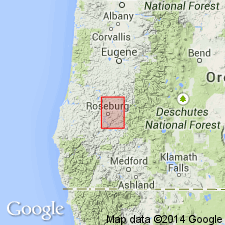
- Usage in publication:
-
- Umpqua formation*
- Modifications:
-
- Original reference
- Dominant lithology:
-
- Sandstone
- Shale
- AAPG geologic province:
-
- Western Columbia basin
Summary:
Umpqua formation. Chiefly thin-bedded sandstones and very thin-bedded shales with some conglomerates; locally contains coal seams, also interstratified calcareous siliceous beds, which, although of small extent, on account of their exceptional character are treated separately as Wilbur formation. (Wilbur tuff lentils). Contains Eocene fossils. Thickness 12,000+/- feet. Underlies Tyee sandstone (new) and unconformably overlies Myrtle formation (new). Of the igneous rocks diabase is associated almost exclusively with Umpqua formation.
[Maps in this folio show Umpqua River flows through Umpqua formation.] Formation present in large area of Roseburg 30-min quadrangle, Douglas and Coos Counties, southwestern Oregon, and westward and northward beyond quadrangle.
Source: US geologic names lexicon (USGS Bull. 896, p. 2213); supplemental information from GNU records (USGS DDS-6; Menlo GNULEX).
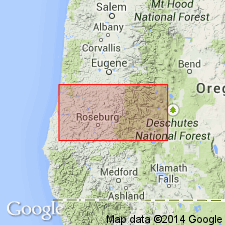
- Usage in publication:
-
- Umpqua formation*
- Modifications:
-
- Overview
- AAPG geologic province:
-
- Oregon-Washington Coast Ranges
- Klamath Mountains
Summary:
Pg. 462-463. Umpqua formation. Described by Diller in Roseburg folio, stretches far beyond Roseburg quadrangle and plays important role in make-up of whole country west of Cascade Range, southwestern Oregon. Age is Eocene.
Source: US geologic names lexicon (USGS Bull. 896, p. 2213).
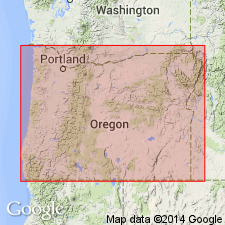
- Usage in publication:
-
- Umpqua formation*
- Modifications:
-
- Adopted
- AAPG geologic province:
-
- Oregon-Washington Coast Ranges province
Summary:
Umpqua formation shown on correlation chart and in section from Buck Peak to Nickel Mountain, OR. [Unconformably] overlies "Myrtle formation" of Cretaceous age. Age given for unit is Eocene.
Source: GNU records (USGS DDS-6; Menlo GNULEX).
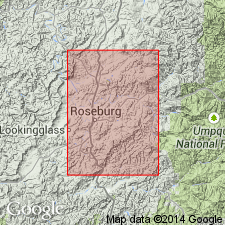
- Usage in publication:
-
- Umpqua formation*
- Modifications:
-
- Biostratigraphic dating
Summary:
Pg. 114-115. SIPHONALIA SUTTERENSIS zone (mollusk) is present in uppermost part of Umpqua formation on Umpqua River near mouth of Little River.
Source: US geologic names lexicon (USGS Bull. 896, p. 2213).
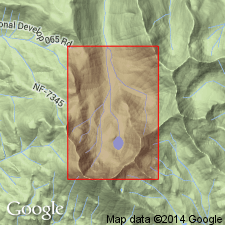
- Usage in publication:
-
- Umpqua formation*
Summary:
[See entry under Arago group.]
Source: US geologic names lexicon (USGS Bull. 896, p. 2213).
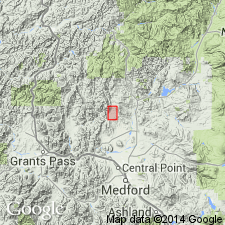
- Usage in publication:
-
- Umpqua formation*
- Modifications:
-
- Revised
- AAPG geologic province:
-
- Oregon-Washington Coast Ranges province
Summary:
Umpqua formation stratigraphically extended to include underlying basaltic rock which was called diabase by Diller (1898). Rocks of Umpqua formation underlie much of region covered in paper including west half of Black-Butte-Elkhead area, Nonpareil-Bonanza area, Meadows district, and probably an area of Buena Vista mine. Age is given as Eocene based on age of fossils of Umpqua in Roseburg quad (Diller, 1898).
Source: GNU records (USGS DDS-6; Menlo GNULEX).
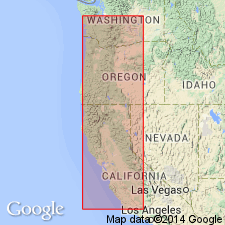
- Usage in publication:
-
- Umpqua formation
- Modifications:
-
- Areal extent
- AAPG geologic province:
-
- Oregon-Washington Coast Ranges province
Summary:
Shown on correlation chart in Roseburg and Comstock areas of western OR. Underlies Tyee formation. Unconformably overlies rocks equivalent to Metchosin formation (or volcanics). Type section of Umpqua formation occurs along north Umpqua River about 17 mi northeast of Roseburg, Douglas Co, OR.
Source: GNU records (USGS DDS-6; Menlo GNULEX).
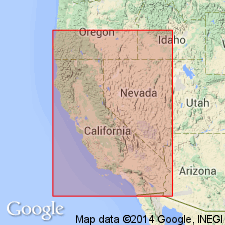
- Usage in publication:
-
- Umpqua(?) formation*
- Modifications:
-
- Areal extent
- AAPG geologic province:
-
- Klamath Mountains province
Summary:
Coal of Eocene age was examined at two localities in Umpqua(?) formation at south end of Rogue River field, Siskiyou Co, and at five localities in Trinity and Humboldt Cos, CA.
Source: GNU records (USGS DDS-6; Menlo GNULEX).
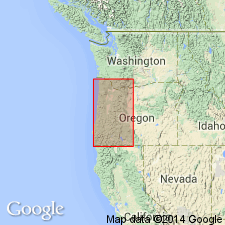
- Usage in publication:
-
- Umpqua formation*
- Modifications:
-
- Areal extent
- AAPG geologic province:
-
- Oregon-Washington Coast Ranges province
Summary:
Umpqua formation of early Eocene age mapped with marine sedimentary rocks in Coast Range, OR. Shown separately are volcanic rocks intercalated with Umpqua. Umpqua formation is restricted from Medford area [these rocks unnamed].
Source: GNU records (USGS DDS-6; Menlo GNULEX).
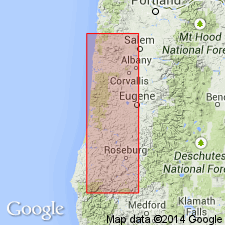
- Usage in publication:
-
- Umpqua Formation*
- Modifications:
-
- Age modified
- AAPG geologic province:
-
- Oregon-Washington Coast Ranges province
Summary:
Age of Umpqua Formation is early to middle Eocene based on foraminifers of Ulatisian Stage in upper part of unit (W.W. Rau, written commun., 1963).
Source: GNU records (USGS DDS-6; Menlo GNULEX).
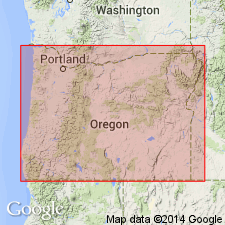
- Usage in publication:
-
- Umpqua Formation
- Modifications:
-
- Not used
- AAPG geologic province:
-
- Oregon-Washington Coast Ranges province
Summary:
Rocks of Umpqua Formation of Baldwin (1964, 1965) herein renamed Roseburg, Lookingglass, and Flournoy Formations. "From the historical viewpoint these formations would be a part of the Umpqua Group; however, the major unconformity between the Roseburg and the Lookingglass Formations may not be in accord with the group concept." p.5
Source: GNU records (USGS DDS-6; Menlo GNULEX).
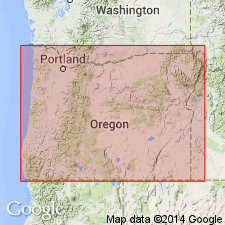
- Usage in publication:
-
- Umpqua Group
- Modifications:
-
- Revised
- AAPG geologic province:
-
- Oregon-Washington Coast Ranges province
Summary:
Roseburg, Lookingglass, and Flournoy Formations of Baldwin (1974) are considered to be units of Umpqua Group. [Baldwin (1974) did not use term "group" because of unconformity. However, Thoms interprets the "apparent unconformity" as due to "differences in competence".] Volcanic rocks of Baldwin's (1974) Roseburg Formation are referred to as Siletz River Formation.
Source: GNU records (USGS DDS-6; Menlo GNULEX).
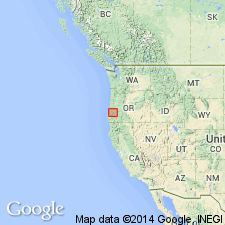
- Usage in publication:
-
- Umpqua Formation*
- Modifications:
-
- Revised
- Overview
- AAPG geologic province:
-
- Oregon-Washington Coast Ranges province
Summary:
Umpqua Formation as used by Wells and Waters (1934) stratigraphically restricted. Basalt [or diabase] below sedimentary rocks of the Umpqua excluded from Umpqua and assigned to the Siletz River Volcanics. As restricted Umpqua consists entirely of as much as 10,000 ft of sedimentary rocks --mudstone or siltstone, sandstone, and conglomerate in decreasing order of dominance. [In Baldwin terminology the excluded rocks are equivalent to his Roseburg Formation]. Age of restricted Umpqua is early and middle Eocene (Penutian and Ulatisian) on basis of foraminifers [on figure 2, p.1219, Molenaar shows queried boundary into the Paleocene. Baldwin's proposal to divide rocks of Umpqua Formation into 3 unconformity-bounded formations (Roseburg, Lookingglass, and Flournoy) not recognized because of questionable correlation and limited extent of some units]. Umpqua Formation includes (ascending): Bushnell Rock, Tenmile, White Tail Ridge, and Camas Valley Members [all not adopted]. Rocks of Baldwin's (1974) Olalla Creek Member are included in White Tail Ridge Member.
Source: GNU records (USGS DDS-6; Menlo GNULEX).
For more information, please contact Nancy Stamm, Geologic Names Committee Secretary.
Asterisk (*) indicates published by U.S. Geological Survey authors.
"No current usage" (†) implies that a name has been abandoned or has fallen into disuse. Former usage and, if known, replacement name given in parentheses ( ).
Slash (/) indicates name conflicts with nomenclatural guidelines (CSN, 1933; ACSN, 1961, 1970; NACSN, 1983, 2005, 2021). May be explained within brackets ([ ]).

